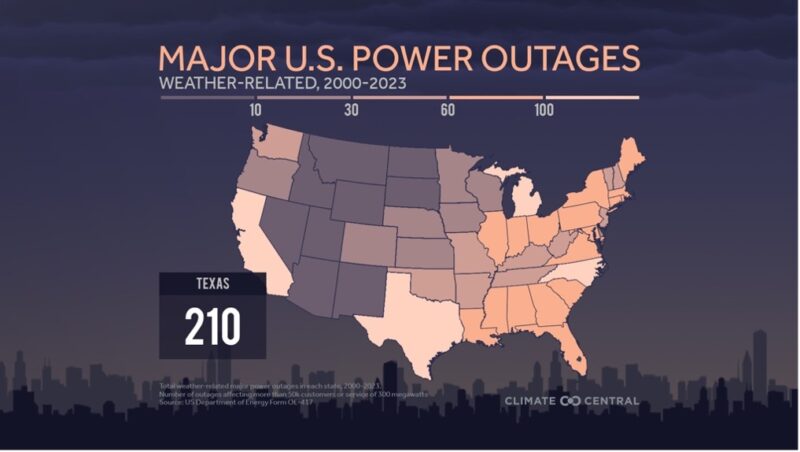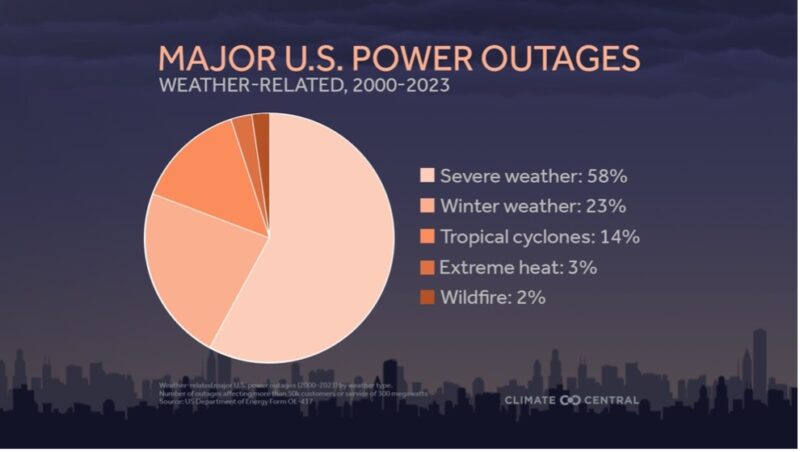 Photo credit: Climate Central
Photo credit: Climate Central
A recent study exposed that Texas leads the country with the most weather-related power outages in a 23-year span, experiencing 210 outages from 2000 to 2023. While the state can be applauded for some energy successes, such as ERCOT’s “connect and manage” process that doesn’t require network upgrades and enables the grid operator to bring new supply capacity to the grid quicker than any other grid operator in the U.S., the state is severely lagging in hardening its energy network. Our infrastructure is old. It is not made to withstand the increasingly strong storms and weather we are experiencing in the 21st century. Instead of being proactive, utilities and state regulators are waiting for the worst to happen and then assessing the damage and questioning what changes and policies need to be made.
Experts anticipate the 2024 hurricane season will be one of the most devastating in the past three decades. Hurricane Beryl, which made landfall and wreaked havoc on parts of the Caribbean in early June, was the earliest category five on record in the past century. Houstonians were without power for days, some even weeks, while repairs to many damaged distribution lines and poles were being made. 80% (1,755) of all major U.S. power outages reported from 2000 to 2023 were due to weather. While it is expected that extreme weather will remain, as pointed out in a new report by Texas A&M University showing that Texas will experience a dramatic rise in 100-degree days and Texans in 2036 are expected to experience quadruple the number of 100-degree days compared to the 1970s and 1980s, there’s much state leaders can do to better prepare homes, businesses and communities to endure these storms and expand resiliency.
 Photo credit: Climate Central
Photo credit: Climate Central
Weatherizing Buildings:
Weatherization strengthens the structural integrity of our buildings and often includes reinforcing windows, doors, and roofs, making buildings more resistant to high winds during hurricanes or extreme heat and cold should the power go out. This is because energy efficiency measures, including sealing gaps, cracks, and other openings, as well as ensuring there is adequate insulation or installing high-performance windows and doors can improve passive survivability; often referred to as a building’s ability to maintain livable conditions in the event of extended loss of power or fuel.
Building Codes:
According to the Insurance Institute for Business & Home Safety (IBHS), minimum improvements over base building code can help homeowners lower the overall cost of their community’s recovery after a disaster. Studies show every $1 spent on disaster mitigation saves $4 in community disaster recovery expenses. This is huge! If local governments and cities adopt current and stronger building energy codes some damage to homes and cities can be averted. Building codes have greatly improved resilience against disasters and set minimum requirements to protect life. It’s worth noting that current codes lead to more efficient buildings, reducing energy use and utility costs. During the 2023 Texas legislative session SB 2453 was passed, however the Governor ultimately vetoed it. Its passing would have allowed to the State Energy Conservation Office (SECO) to raise state minimum standards. Currently, the state is on the 2018 building code and the 2015 energy code.
Distributed Energy Resources (DERs):
As more storms and stronger hurricanes occur, more damage to the power system occurs, often bringing down transmission and distribution lines and poles, which are both costly and time consuming to repair. DERs offer an opportunity to increase reliability and resiliency to electric grids. In Texas, the PUCT has established an aggregated DER, or ADER, pilot program. In addition to the pilot program, the PUCT will undertake implementing SB 1699, allowing the participation of aggregated distributed energy resources, which can come in the form of battery storage, rooftop solar, or even electric vehicles among other devices. Combined, these resources have the ability to increase the grid’s resilience, especially during natural disasters, by ensuring there is enough electricity or back up electricity.
Cost Savings and Other Benefits:
Energy efficient and properly weatherized buildings typically suffer less damage during hurricanes, thus needing fewer repairs and lowering maintenance costs following a storm. This is yet another reason adopting updated energy codes is fundamental to combat weather year-round, but especially during the height of hurricane season.
While some insurance companies offer lower premiums or discounts for buildings that have been weatherized or reinforced, seeing as they are lower-risk structures, more recently extreme weather has sent insurance rates skyrocketing, or even worse companies have decided not to cover certain weather-prone regions altogether. This is especially cumbersome and has a disproportionate impact on low-income families, who commonly struggle with higher energy burdens.
We’ve included some helpful articles below to help you prepare for the next storm and to fortify both your home and the energy grid. Save money, improve your indoor comfort, and the environment by making your building more energy efficient.